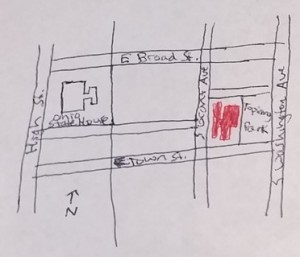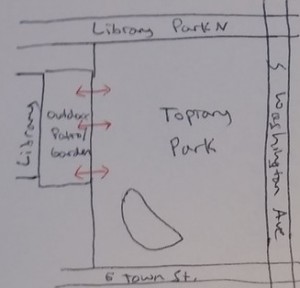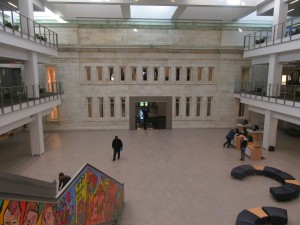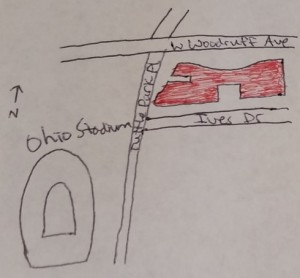By Ian Meadows
Located in the heart of the Discovery District, the main branch of the Columbus Metropolitan Library makes quite an impressive statement architecturally and functionally. It recently went through a complete renovation to allow it to better meet the needs of an increasingly technologically advanced and progressive society. While the grand front façade and ornate interior marble remained after the renovation, the building was given a new life. It is now filled with large open spaces, contemporary design elements such as the use of glass and floating staircases, and an abundance of natural light. Simply walking up to and then inside of the library evokes amazement and curiosity.

Figure 1: The library (red) in relation to its surroundings such as nearby roads, the Ohio Statehouse, and Topiary Park.
The entire building gives off a sense of advancement, education, and wonder. The renovation was able to successfully maintain its historical significance while ensuring it can be projected into the current society and beyond. As previously discussed with Knowlton Hall, one of the best elements is the seamless flow from space to space. The expansive atrium on the main level provides for an excellent area to congregate and admire the beautiful interior space. However, while there are a few seats, there is a shortage of functional space considering how much area this atrium occupies. If there is any critique of the library, it would be the underdeveloped atrium, since so many more comfortable seating areas could be set up instead of a vast floor devoid of places to sit and enjoy the space to its true potential. This does not in any way though detract from the beauty and quality of the library, since the rest of the building goes above and beyond both visual and educational needs for the community. The vastness of the atrium may even be viewed as an asset, placing focus on the versatile and ambiguous design of the exceptional space.

Figure 3: The atrium is a figural void that creates a distinctive architectural character of the interior.
Moving on from the atrium yet still focusing on the inclusion of large, bright spaces is a massive reading room on the second level. Here there is an abundance of tables and chairs, and walls of windows let plentiful light stream in. An inviting, peaceful atmosphere conducive to learning, studying, and reading is achieved. Thanks to these bright, open spaces in the library, its renovation has created many more functional and enjoyable spaces throughout the entire building.

Picture 3: Large windows and expansive space give reading rooms like this one a relaxing, welcoming atmosphere.
The building continues to exhibit exceptional flow through its rear entrance. A coffee shop entices visitors to stop by and relax and then to proceed outside to enjoy the library’s pleasant garden patio. Just behind this is Columbus’ Topiary Park. There is a very effective connection between the library and its surroundings, including this park and the rest of the Discovery District. It is very well thought out, creating an easy and intriguing way to progress from inside the library to the exterior, especially in this case of the Topiary Park. In result, more people are able to enjoy this other Columbus feature that might not have previously done so. Architecture firm Schooley-Caldwell states on a page of their website that one of the goals for the library’s renovation project is to “better connect the library with the adjacent Topiary Park and with the Discovery District as a whole” (“Columbus Metropolitan Library: Main Library Renovation”). The interior of the library is very important, but just as much attention was paid to the exterior and how to connect it with its surroundings. The library could even be used as a catalyst to spark further development and enhancement around other areas of the district.

Figure 4: Two main entry and exit points disperse circulation into the rest of the building as well as outside, either in the front or back.

Figure 5: There is a direct flow and connection between the library’s rear patio and the Topiary Park.
Not just a space to enter, quickly find a book, and leave again, the renovated Main Branch of the Columbus Metropolitan Library entices visitors to stay and relax for a while in one of many grand, comfortable lounge areas. There are even study rooms and a children’s section to cater to all needs and interests. Not only is the library architecturally stunning, but its functionality is second to none. It is both a progressive building and an institution that will ensure the future of learning and reading will be in good hands, and all inside an equally innovative physical structure.
Sources
“Columbus Metropolitan Library: Main Library Renovation.” Schooley Caldwell Architects. N.p., n.d. Web. 17 Nov. 2016.







